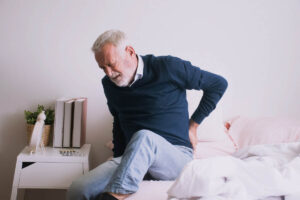Knee pain can be frustrating and debilitating, especially when it interferes with everyday activities like walking, exercising, or even when it hurts to straighten the knee. This common problem affects people of all ages and activity levels, and understanding the underlying medical conditions can be key to finding the right treatment. In this article, we’ll explore the anatomy of the knee, explore common conditions that cause knee pain when straightening the leg, and discuss various treatment options available to alleviate this pain.
Anatomy of the Knee and Its Role in Leg Movement
The knee is one of the most important joints in the human body, as it is the transitional joint between a complex ankle, and a complex hip joint. It is a hinge joint formed by the femur (thigh bone), tibia (shin bone), and patella (kneecap) sitting on top. The knee allows for flexion and extension of the leg, playing a crucial role in walking, running, squatting, and jumping. Several ligaments, tendons, and connective tissue surround the knee, providing stability and strength. The ACL, PCL, medial collateral ligament, and lateral collateral ligament are all crucial for the knee’s stability.
The patella sits in front of and on top of the knee joint, within the quadriceps tendon, and glides over the femur as the leg bends and straightens. This movement is facilitated by the smooth cartilage layer that lines the bones and the synovial fluid that lubricates the joint. Any damage or inflammation to these structures can lead to severe pain, especially when the knee is straightened.
Common Causes of Knee Pain When Straightening Leg
Many people ask, “Why does my knee hurt when I straighten it?” This pain can be attributed to various factors, ranging from overuse injuries to degenerative health conditions. Below are some of the most common causes:
Patellofemoral Pain Syndrome
Patellofemoral Pain Syndrome is one of the most common types of knee pain, particularly in athletes and active individuals. It occurs when the patella does not track properly over the femur, leading to irritation of the patella cartilage underneath the kneecap. This condition is often exacerbated by activities that involve repetitive knee motion, such as running or jumping. In fact, the annual prevalence of patellofemoral pain in the general population was reported as 22.7%, highlighting how widespread this issue can be.
Tendonitis
Tendonitis is the inflammation of a tendon, the thick, tough bands that attach muscles to bones. In the knee, tendonitis often affects the patellar tendon, which connects the quadriceps muscle to the shinbone. This condition, also known as “jumper’s knee,” is common in athletes who engage in sports that require frequent jumping. Pain is typically felt at the front of the knee, especially when straightening the leg, a common complaint among athletes.
Meniscus Tears
The menisci per knee are C-shaped pieces of cartilage that act as a cushion between the femur and tibia. A meniscal tear can occur due to sudden twisting or turning motions, often during sports activities. Meniscus injuries can cause sharp pain, swelling, and difficulty straightening the leg, often resulting in pain in back of knee when straightening leg.
Osteoarthritis
Knee Osteoarthritis is a degenerative joint disease that occurs when the cartilage layer that cushions the bones in the knee wears down over time. This condition is more common in older adults and can lead to pain, stiffness, and a reduced range of motion. In 2019, about 528 million people worldwide were living with osteoarthritis, making it a leading cause of disability. The study found that the overall prevalence of pain in or around the knee was 47% (men 44% and women 49%), with women showing higher levels of self-reported knee pain.
IT Band Syndrome
Iliotibial band syndrome occurs when the IT band, a thick band of tissue running from the hip to the shin, becomes tight or inflamed. This condition is common in runners and cyclists and can cause pain on the outside of the knee, especially when the leg is straightened.
Bursitis
Knee Bursitis is the inflammation of the bursae, small fluid-filled sacs that cushion the knee joint. When the bursae become irritated, usually due to repetitive motion or prolonged kneeling, it can lead to pain and swelling. Prepatellar bursitis can make it difficult to fully straighten the leg.
Knee Ligament Injuries
Injuries to the ligaments of the knee, such as the anterior cruciate ligament (ACL) or the posterior cruciate ligament (PCL), can cause significant pain and instability. These injuries are often the result of trauma or sudden changes in direction during sports. Pain when straightening the leg is common, along with swelling and difficulty bearing weight on the affected leg. A cruciate ligament injury can also lead to a feeling of the knee “giving way.”
Muscle Imbalance
Muscle imbalances, particularly in the quadriceps, gluteals, hip external rotators, and hamstrings, can put excessive strain on the knee joint, leading to pain. Weakness in certain muscles can alter the alignment of the knee, causing the patella to track improperly and leading to discomfort when the leg is straightened.
Symptoms Associated with Knee Pain When Straightening Leg

Knee pain when straightening the leg can manifest in various ways, depending on the underlying cause. Common symptoms include:
Pain or Dull Ache
The most common symptom is a sharp or dull type of pain in the knee when extending the leg. This pain may be localized to a specific area, such as the front, back, or sides of the knee.
Knee Stiffness
Stiffness in the knee joint can make it difficult to fully straighten the leg. A feeling of tightness or resistance within the knee often accompanies this, particularly in cases of Chronic Knee Pain.
Knee Clicking or Popping
Some individuals may experience clicking or popping sounds in the knee when straightening the leg. This can be due to the movement of tendons, ligaments, or the patella over bony structures, possibly indicating an unnatural twisting of the joint.
Instability
A feeling of instability or the knee “giving way” can occur, particularly with ligament tears. This may cause a lack of confidence in bearing weight on the affected leg.
Limited Mobility
Knee pain can limit your range of motion, hindering your ability to fully extend your leg. This discomfort can interfere with everyday activities and reduce overall mobility, often leading to a limited range of motion.
Swelling
Swelling in the knee joint is a common symptom of inflammation, injury, or degenerative conditions. This can lead to discomfort and difficulty moving the knee. Swelling can also indicate a more serious knee injury, especially if accompanied by bruising or bluish discoloration.
Diagnosing the Cause of Knee Pain
Diagnosing the cause of knee pain when straightening the leg typically involves a combination of physical examination, medical history review, and imaging tests.
Physical Examination
A thorough physical examination by a health care provider, such as those at Austin Manual Therapy Associates, can help identify the source of the pain. This may include assessing the knee’s range of motion, checking for tenderness, and evaluating muscle strength, and balance.
Medical History Review
Reviewing the patient’s medical history, including any previous injuries, surgeries, or chronic conditions like a history of arthritis, can provide valuable insights into the cause of the knee pain.
Imaging Tests
Imaging tests, such as magnetic resonance imaging (MRI), X-rays, or ultrasound, may be recommended to visualize the structures within the knee and identify any abnormalities, such as meniscal injuries, ligament injuries, or types of arthritis.
Treatment Options for Knee Pain When Straightening Leg
Treatment for knee pain when straightening the leg depends on the underlying cause. It can range from conservative methods to more advanced medical interventions.
Conservative Treatments
Conservative treatments involve noninvasive approaches to alleviating knee pain, such as physical therapy, rest, and ice therapy. These methods focus on reducing inflammation and strengthening the surrounding muscles to improve mobility and function.
Rest, Ice, Compression, and Elevation (RICE)
The RICE method is often the first line of treatment for knee pain. Resting the knee, applying an ice pack, using an elastic bandage or compression bandages, and elevating the leg can help reduce inflammation and pain.
Over-the-counter Medications
Nonsteroidal anti-inflammatory drugs (NSAIDs) like ibuprofen can help manage pain and reduce inflammation. These anti-inflammatory medications are often recommended for reducing pain caused by common knee injuries.
Physical Therapy
Physical therapy treatment is a crucial component of recovery, particularly for muscle imbalances, tendonitis, and post-injury rehabilitation. A physical therapist can design a personalized exercise regime to strengthen the muscles around the knee, improve flexibility, and restore normal movement patterns. A good exercise plan should focus on strengthening core muscles and improving joint stability.
Medical Interventions
For more severe cases of knee pain, medical interventions may be necessary. Options can include corticosteroid injections, hyaluronic acid injections, or even surgical procedures to repair damaged tissues or alleviate pain.
Corticosteroid Injections
Corticosteroid injections can reduce inflammation and pain in severe arthritis or bursitis. These injections provide temporary relief and are often used when conservative treatments are not effective.
Surgery (as a Last Resort)
In some cases, surgery may be necessary to repair damaged tissues, such as a torn meniscus or torn ligament. Surgical options vary depending on the specific injury and may include arthroscopic surgery, ligament reconstruction, or joint replacement.
Prevention Tips to Avoid Knee Pain
Preventing knee pain involves maintaining strong and flexible muscles, using proper techniques during physical activities, and wearing appropriate footwear or arch supports. Regular exercise, including strength training and stretching, can help keep the knee joint healthy and reduce the risk of injury. Avoiding excess body weight or losing healthy weight can also reduce strain on the knee joints.
When to Seek Medical Help for Knee Pain

It is important to seek medical help if knee pain persists for more than a few days, worsens over time, or is accompanied by significant swelling, instability, severe pain, or an inability to bear weight on the leg. Early intervention can prevent further damage and improve the chances of a full recovery.
Conclusion
Knee pain when straightening the leg can have a significant impact on your daily life, but with the right diagnosis and treatment, relief is possible. Whether the pain is due to overuse, injury, or a degenerative condition, understanding the underlying cause is the first step toward effective treatment. If you are experiencing knee pain, consider consulting with a physical therapist at Austin Manual Therapy Associates for a personalized diagnosis, prognosis, and treatment plan.
FAQ’S
Why can’t I straighten my knee without pain?
Pain when straightening the knee can be caused by various factors, including patellofemoral pain syndrome, tendonitis, or meniscus injuries. It is important to seek a proper diagnosis to determine the exact cause.
Why does my patellar tendon hurt when I straighten my leg?
Pain in the patellar tendon when straightening the leg is often due to tendonitis, an inflammation of the tendon. This condition is common in athletes and can be treated with rest, ice, and physical therapy.
Why does my knee feel tight when I straighten it?
A tight feeling in the knee when straightening may be due to stiffness from inflammation, swelling, or muscle imbalance. Stretching, strengthening exercises, and proper warm-up techniques can help alleviate this sensation.





